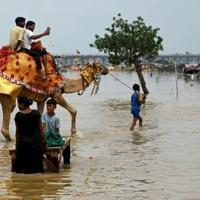Torrential storms lashing India and Nepal have claimed hundreds of lives since June, according to official data released on Tuesday. The floods and landslides caused widespread devastation during the hazardous monsoon season.
The death toll includes numerous fatalities in India this month alone, with at least 171 deaths reported in neighboring Nepal overall.
Weather-related disasters are a common occurrence during the monsoon season, which lasts from June to September. Experts believe that climate change is contributing to the increased frequency and severity of these events.
In India, following the country’s longest-ever heatwave earlier this year, intense rainstorms have led to extensive flooding and landslides.
The scorching heatwave in May and June saw temperatures in New Delhi matching the capital’s previous record high of 49.2C (120.5F) recorded in 2022.
Now, the heat has given way to heavy rains.
The Indian weather department has issued warnings of “heavy rainfall” in many southern and northeastern states.
Rescue operations are underway to locate two missing individuals after nine people drowned in a surging water incident in the Una district of Himachal Pradesh state.
“The search for the missing individuals is ongoing,” stated district official Shikha Rana to AFP.
Witnesses described a car being swept away by the swollen muddy river.
In the northern state of Uttar Pradesh, at least 17 people have lost their lives in floods caused by heavy rains over the past week, as per official records. The usually arid deserts of Rajasthan have also been inundated, resulting in at least 22 fatalities due to flooding since Sunday.
In Uttarakhand, surging waters have claimed the lives of at least 51 people since June, according to state government data.
In Nepal, 171 people have died since the start of the monsoon rains in mid-June, including 109 in landslides, with additional fatalities due to floods and lightning.
Search efforts are ongoing in various regions for missing persons, providing critical updates on the situation.
Monsoon rains are essential for replenishing water sources and supporting agriculture, crucial for the livelihoods of millions of farmers and food security for South Asia’s population.
India, as the world’s third-largest emitter of greenhouse gases, has pledged to achieve a net zero emissions economy by 2070, heavily reliant on coal for power generation at present.
strs-pa-ash/pjm/fox





